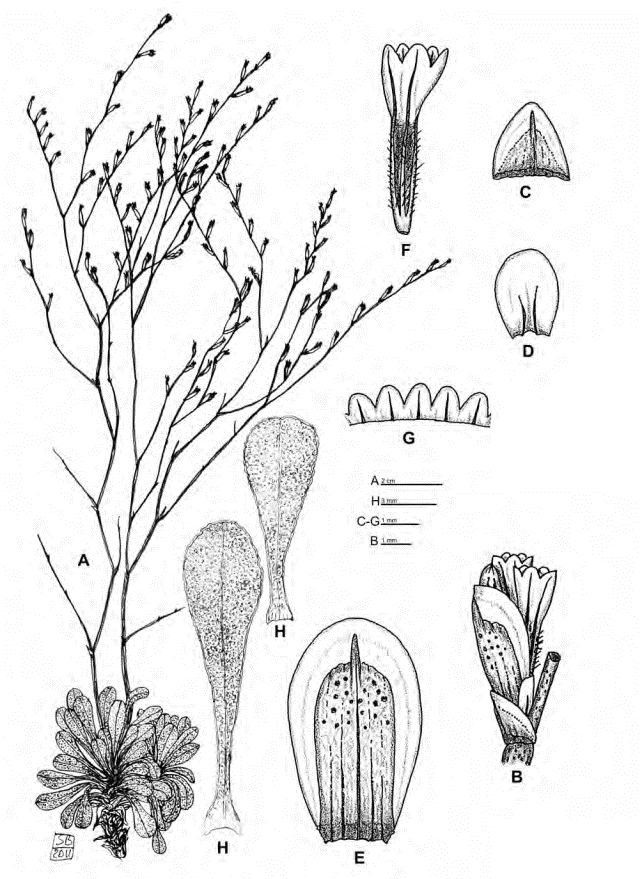LIMONIUM GRABUSAE
1. Limonium grabusae Erben & Brullo, sp. nov. (Fig. 61)
Type:-GREECE. Crete: Insula Creta: Distr. Kissamos: Insula Grabusa, substr. calc., 25 July 1973, Rechinger 45792
(holotype B!).
Diagnosis:-Planta perennis, glabra, glauca, 15-35 cm alta, foliis 20-40 × 6-10 mm, spathulatis ad oblanceolatis, verrucosis ad tuberculatis,1-nerviis, caulibus paucis, verrucosis, ramis sterilibus nonnullibus, spicis 20-80 mm longis, spiculis 7.5-8.2 mm longis, 1-3-floris, ad 1-4 in 2 centimetris dispositis, bractea inferiore 2.1-2.3 × 2.0-2.2 mm, triangulari- elliptica, bractea media 2.2-2.6 × 1.3-1.9 mm, bractea superiore 5.9-6.5 × 3.3-4.0 mm, oblongo-obovata, margine late membranaceo, calyce 5.4-6.0 mm longo, ex bractea superiore 1.0-1.5 mm exserto, tubo breviter piloso, lobis calycis ca.
1.7 × 0.8 mm, semi-ellipticis.
Description:-Plant perennial, glabrous, forming a sub-shrub 15-35 cm tall, with few erect stems and a robust tap- root. Caudices 4-9 cm long, loosely branched and densely spirally leafy with withered leaves; living leaves in rosettes at apices. Leaves fleshy, glaucous, flat, verrucate to tuberculate with crateriform glands, 20-40 mm long and (3-)5-10 mm broad, spathulate to oblanceolate, apex obtuse to round, sometimes retuse, with one central nerve, gradually tapering into the petiole. Stems glaucous, 10-30 cm long, slightly flexuous, verrucate, branching begins above the base of the stems. Inflorescence trullate or obtrullate in outline. Sterile branches only 1-3 per stem, 1-5 cm long, straight to slightly curved, unbranched. Fertile branches 3-8 cm long, slightly arched to straight, directed obliquely upwards, forming branching angles of 35°- 50°, normally unbranched. Spikes 20-80 mm long, arched, inserted obliquely or spreading. Spikelets 7.5-8.2 mm long, composed of 1-3 flowers, very remotely arranged with 1-4 per 2 cm. Outer bract 2.1-2.3 mm long and 2.0-2.2 mm broad, triangular-elliptic, obtuse; bract margin broadly membranous; central part slightly fleshy, sometimes only at the base, acuminate. Middle bract membranous, 2.2-2.6 mm long and 1.3-1.9 mm broad, oblong to obovate-elliptic, rounded. Inner bract 5.9-6.5 mm long and 3.3-4.0 mm broad, oblong-obovate, obtuse to rounded; bract margin broadly membranous; central part fleshy, slightly tuberculate, 4.3-5.0 mm long and 2.0-3.0 mm broad, oblong, acuminate, forming a narrowly triangular tip, 1.0-1.2 mm long, not reaching the upper margin. Calyx 5.4-6.0 mm long, exceeding the inner bract by 1.0-1.5 mm; calyx tube shortly hairy, with 5 ribs ending near the upper margin of lobes; calyx lobes ca. 0.7 × 0.8 mm, semi-elliptic. Corolla lilac.
Distribution:-Restricted to Gramvousa, islet of northwest Crete (Fig. 88I).
Habitat:-Calcareous rocky coast.
Etymology:-L. grabusae is named after Grabusa (= Gramvousa), an islet near Crete.
Taxonomic remarks:-L. grabusae is similar to L. sougiae, but its larger leaves and shorter spikelets, bracts and calyces make it distinct from the latter.
Type:-GREECE. Crete: Insula Creta: Distr. Kissamos: Insula Grabusa, substr. calc., 25 July 1973, Rechinger 45792
(holotype B!).
Diagnosis:-Planta perennis, glabra, glauca, 15-35 cm alta, foliis 20-40 × 6-10 mm, spathulatis ad oblanceolatis, verrucosis ad tuberculatis,1-nerviis, caulibus paucis, verrucosis, ramis sterilibus nonnullibus, spicis 20-80 mm longis, spiculis 7.5-8.2 mm longis, 1-3-floris, ad 1-4 in 2 centimetris dispositis, bractea inferiore 2.1-2.3 × 2.0-2.2 mm, triangulari- elliptica, bractea media 2.2-2.6 × 1.3-1.9 mm, bractea superiore 5.9-6.5 × 3.3-4.0 mm, oblongo-obovata, margine late membranaceo, calyce 5.4-6.0 mm longo, ex bractea superiore 1.0-1.5 mm exserto, tubo breviter piloso, lobis calycis ca.
1.7 × 0.8 mm, semi-ellipticis.
Description:-Plant perennial, glabrous, forming a sub-shrub 15-35 cm tall, with few erect stems and a robust tap- root. Caudices 4-9 cm long, loosely branched and densely spirally leafy with withered leaves; living leaves in rosettes at apices. Leaves fleshy, glaucous, flat, verrucate to tuberculate with crateriform glands, 20-40 mm long and (3-)5-10 mm broad, spathulate to oblanceolate, apex obtuse to round, sometimes retuse, with one central nerve, gradually tapering into the petiole. Stems glaucous, 10-30 cm long, slightly flexuous, verrucate, branching begins above the base of the stems. Inflorescence trullate or obtrullate in outline. Sterile branches only 1-3 per stem, 1-5 cm long, straight to slightly curved, unbranched. Fertile branches 3-8 cm long, slightly arched to straight, directed obliquely upwards, forming branching angles of 35°- 50°, normally unbranched. Spikes 20-80 mm long, arched, inserted obliquely or spreading. Spikelets 7.5-8.2 mm long, composed of 1-3 flowers, very remotely arranged with 1-4 per 2 cm. Outer bract 2.1-2.3 mm long and 2.0-2.2 mm broad, triangular-elliptic, obtuse; bract margin broadly membranous; central part slightly fleshy, sometimes only at the base, acuminate. Middle bract membranous, 2.2-2.6 mm long and 1.3-1.9 mm broad, oblong to obovate-elliptic, rounded. Inner bract 5.9-6.5 mm long and 3.3-4.0 mm broad, oblong-obovate, obtuse to rounded; bract margin broadly membranous; central part fleshy, slightly tuberculate, 4.3-5.0 mm long and 2.0-3.0 mm broad, oblong, acuminate, forming a narrowly triangular tip, 1.0-1.2 mm long, not reaching the upper margin. Calyx 5.4-6.0 mm long, exceeding the inner bract by 1.0-1.5 mm; calyx tube shortly hairy, with 5 ribs ending near the upper margin of lobes; calyx lobes ca. 0.7 × 0.8 mm, semi-elliptic. Corolla lilac.
Distribution:-Restricted to Gramvousa, islet of northwest Crete (Fig. 88I).
Habitat:-Calcareous rocky coast.
Etymology:-L. grabusae is named after Grabusa (= Gramvousa), an islet near Crete.
Taxonomic remarks:-L. grabusae is similar to L. sougiae, but its larger leaves and shorter spikelets, bracts and calyces make it distinct from the latter.

FIGURE 61. Limonium grabusae Erben & Brullo. A) Habit; B) Spikelet; C) Outer bract; D) Middle bract; E) Inner bract; F) Calyx; Calyx lobes; H) Leaves. (Habit and leaves drawn from “C. Fournaraki 5802, CAT”, spikelet details from “K.H. Rechinger 45792,B”).